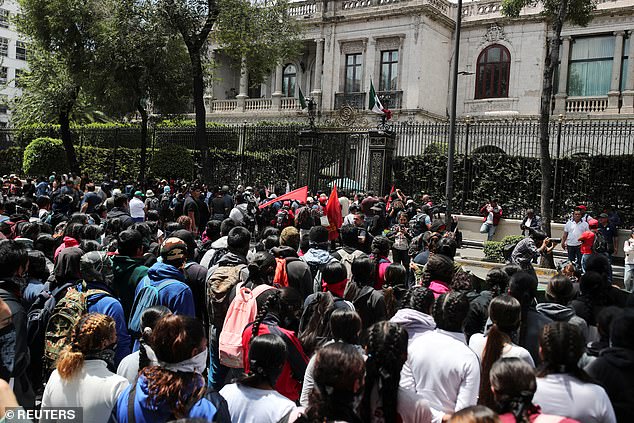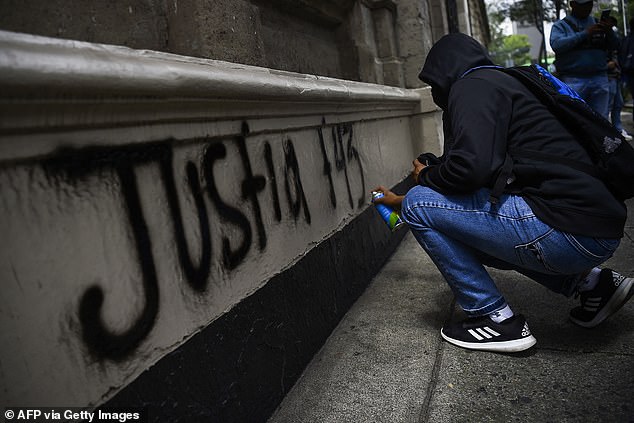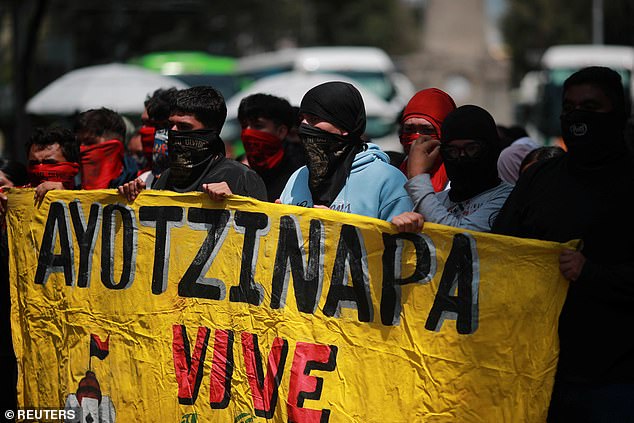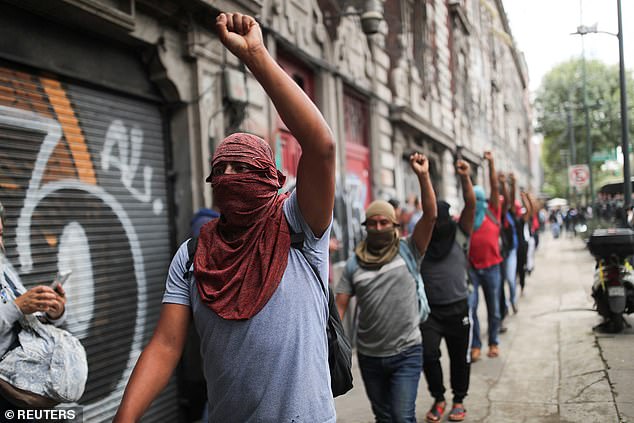What happened to Mexico’s 43 missing students? Devastated families demand answers 10 years after pupils vanished
Classmates protesting the disappearance of 43 students from a rural Mexican teacher training college attacked a government building during a demonstration on Monday.
The group joined families of the missing students for a protest in Mexico City to mark the 10th anniversary of their disappearance in a country where more than 115,000 people are registered missing.
Students were seen covering their faces and throwing Molotov cocktails and other objects at the Ministry of Internal Affairs building.
The missing students were attending the Rural Normal School in Ayotzinapa in Iguala, a city in the state of Guerrero on the Pacific coast. On September 26, 2014, they were attacked by security forces linked to Guerrero Unidos, a local drug gang.
A protester throws a homemade explosive device at the headquarters of the Ministry of the Interior in Mexico City on Monday, following a demonstration against the 43 students of the Rural Normal School in Ayotzinapa, who disappeared on September 26, 2014.

Families hold signs for 43 teachers’ college students who were allegedly murdered by a drug gang in Iguala, a city in the Pacific coastal state of Guerrero, on September 26, 2014. The parents and classmates have demanded justice from the administration of President Andrés Manuel López Obrador
The students traveled in five buses to Mexico City to attend the commemoration of the nearly 300 people who were massacred during a student protest in 1968.
The government of President Enrique Peña Nieto said at the time that the students were mistaken for members of a rival gang and that the Guerreros Unidos had kidnapped and killed them. They said the gang had burned their bodies in a fire and dumped them in a river.
However, an investigation by the Inter-American Commission on Human Rights, the subsequent Office of the Attorney General, and a truth commission created in 2019 found that the landfill fire was a hoax, based on false statements obtained under torture and evidence that had been manipulated.
Investigators would later discover that a massive operation had been launched that night involving members of Guerreros Unidos, as well as local, state and federal police.
They discovered that the army knew everything that was happening because it had a base in Iguala, had soldiers on the streets and spies among the students.

Protesters and relatives of 43 students from the Rural Normal School in Ayotzinapa held a protest on Monday to mark the 10th anniversary of their disappearance in Mexico City, Mexico, before it turned violent

A student paints graffiti on the entrance to the Ministry of the Interior during a demonstration demanding justice for the 43 students of the Rural Normal School in Ayotzinapa who disappeared on September 26, 2014.
Investigators said members of the military were involved in the gang that smuggled heroin from the mountains of Guerrero on buses to the United States. Prosecutors said the decision to conceal the truth was made at the highest levels of government.
Authorities have arrested more than 100 people and charged dozens, but only one has been convicted of a crime.
At the end of the previous administration, Mexican courts ruled that the investigation was plagued by errors and manipulation, and there were dozens of cases of torture.
Those abuses and missteps led to the release of many of those involved. Some have been rearrested under the current administration of President Andrés Manuel López Obrador, who has promised in the past to help the families get justice.
The top defendant is former Attorney General Jesús Murillo Karam, who is accused of torture, enforced disappearance and obstruction of justice.

At least 100 people linked to the disappearance of the 43 students have been arrested. The highest-ranking person charged is former Attorney General Jesús Murillo Karam, who is accused of torture, enforced disappearance and obstruction of justice.

Students march through the streets of Mexico City, near the Interior Ministry, calling on the government of President Andrés Manuel López Obrador to respond to the disappearance of 43 students.
There are also 16 soldiers, most of whom are under house arrest awaiting trial, angering the students’ families.
But as more evidence mounted pointing to the military’s involvement in the attack and the cover-up, the tone of López Obrador’s government changed.
The president had ordered the military to open its archives to researchers. That did not happen.
Instead, López Obrador gave more power and responsibility to the military than any president in recent history.
The prosecutor leading the investigation, Omar García Trejo, was suddenly demoted after requesting arrest warrants for two dozen soldiers, and was replaced by someone unfamiliar with the case.
There was also mounting political pressure to show results, said Santiago Aguirre, one of the families’ lawyers. The government presented some evidence that did not appear to come from reliable sources, and the government’s searches became sloppy.
Their lawyers point out that key arrests are still missing, including that of the man who led the investigation during Peña Nieto’s government, Tomás Zerón.
Videos show Zerón interrogating and threatening prisoners. He sought refuge in Israel, which has not agreed to his extradition despite Mexico’s request.
They also want to see the military intelligence reports from that night, but they still don’t have access to them.
They have appealed for more cooperation from the US government, which has prosecuted members of Guerreros Unidos in drug trafficking cases that have also exposed their ties to the military.
